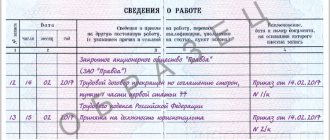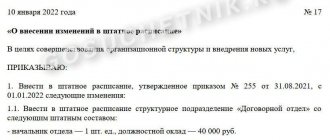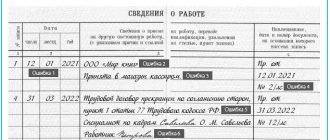Normative base
There is no single law that regulates certification. When determining the qualification level, a special commission of the employer must rely on existing professional standards. For example, the certification of employees for compliance with their positions in the field of culture is regulated by an industry document - letter of the Ministry of Culture dated 02/08/2010 No. 7790-44/04-ПХ. Other standards are provided for managers of federal state unitary enterprises: certification is carried out in accordance with Decree of the Government of the Russian Federation No. 234 of March 16, 2000.
In general, certification is not a mandatory procedure. But for some workers, periodic certification of workers is mandatory. These include:
- teaching staff (Article 49 273-FZ of December 29, 2012);
- state and municipal employees (Article 33 342-FZ of November 30, 2011, Article 33 141-FZ of May 23, 2016, Article 48 79-FZ of July 27, 2004, Article 18 25-FZ of March 2, 2007).
Such employees are subject to increased requirements in terms of qualifications and professionalism.
The audit is carried out in accordance with the certification regulations approved by the organization. It must be written in:
- requirements for employees;
- categories of employees subject to inspection;
- timing and frequency;
- grounds for certification;
- composition of the certification commission;
- rules for recording control results.
To schedule certification, the employer issues an order indicating the last name, first name, position, name of the unit in which the applicant works, the dates of the certification, the list of documents provided for the assessment, and the names of the employees responsible for their preparation. The order also indicates the composition of the certification commission.
When carrying out, a certain sequence of stages in preparing for personnel certification must be observed: the inspection is preceded by preparatory work organized by the heads of cultural institutions. At this time, the goals, conditions and forms of control are explained to employees. Employees also become familiar with the materials prepared for the commission.
Next, the certification commission gets acquainted with the materials provided for each employee. The test is carried out by the employer in the form of written testing, an interview, an exam, etc. The form of certification depends on the specifics of the subject’s work activity. For cultural workers, there are other forms of testing, for example, watching a performance in which the subject is involved. Based on the assessment results, the commission makes its decision.
ConsultantPlus experts discussed how to fire an employee due to incompatibility with the position held (the work performed). Use these instructions for free.
How is certification carried out?
Certification must be carried out in accordance with approved standards for professions (Article 195.1 of the Labor Code of the Russian Federation). First of all, this concerns mandatory certification and the professions to which it applies. At the same time, based on the meaning of this article, if the management of a commercial organization conducts certification of employees, it is obliged to be guided by the same article.
The main document regulating the procedure is the Certification Regulations. Schematically, the document consists of several important blocks, developed and supplemented in accordance with the specifics of its work:
- Concept, goals, objectives of certification. Here you can declare the determination of the level of qualifications and the establishment of incentive measures.
- Workers subject and not subject to certification. It should be especially emphasized that young specialists, pregnant women and other protected workers do not undergo certification.
- Terms and forms of certification. Scheduled and unscheduled certification, their conditions. Typically, the elective procedure is performed at least once every five years or more often. Deadlines are established by law for each profession. Commercial organizations should also follow these standards. The form can be written, through an interview, etc.
- Certifying commission. If the organization has a trade union, the inclusion of its representative in the commission is mandatory (Article 82 of the Labor Code of the Russian Federation), otherwise the commission’s decision can be declared illegal through the court, as judicial practice confirms.
- Evaluation criteria. They must be based on the employee’s responsibilities described in the employment contract and the complexity of the work he performs.
- Carrying out certification. It is recommended to describe in detail the procedure for notifying the employee (optimally a month in advance), commission meetings, voting, reflecting its results, and bringing them to the attention of employees.
- Results. The result of certification can be formulated as follows:
- corresponds/does not correspond to the position held;
- conditionally corresponds to the position;
- conditionally complies with the implementation of the recommendations of the certification commission (can be supplemented with provisions on unscheduled certification, again).
The document should be familiarized to employees against signature.
In addition to the regulations on certification of the commission, it is necessary to develop a schedule of certification activities and coordinate it with employees. For the certification commission to work, it needs information about each employee: in the form of a certificate, characteristics or any other form provided by the LNA.
The entire above procedure at the initial stage of the certification process (approval of the composition of the commission, list of professions and positions, schedule, procedure for preparing documents by the personnel service, informing employees) is formalized by an order for the organization, with which employees must be familiarized with signature.
The result is recorded in the protocol of the commission or in the certification sheet filled out for each employee. Based on these documents, the manager issues an order in relation to each employee who has passed or failed the certification.
All certification documents, including characteristics and certification sheets, are stored in the employee’s personal file as personnel documentation. Starting from 2003, the storage period for it is 50 years, for earlier documents - 75 years (FZ-125 dated 10/22/04, Article 22.1).
Purpose of certification
An employer pursues different goals when deciding to conduct a check on its employees. Often such measures are associated with the desire to fire an employee who cannot cope with his duties.
According to paragraphs 3 and 14 of Article 81 of the Labor Code of the Russian Federation, the employer has the right to dismiss an employee if he is not suitable for the position held. This fact is established by the procedure for determining whether an employee meets the requirements of the position held. If the test results confirm the employee's incompetence, the employer uses them as grounds for dismissal. Consequently, such an assessment serves as a tool to confirm that the employer is right when dismissing an employee who cannot cope with his duties.
IMPORTANT!
It is worth remembering that before dismissing such an employee, the employer is obliged to offer him another job that requires less qualifications. Some categories are protected by Article 261 of the Labor Code of the Russian Federation. This means that the employer does not have the right to fire them, even if they demonstrate poor results on the test. For example, these include pregnant women, single mothers, mothers of children under three years of age, and so on.
For employees who were fired in accordance with paragraph 3 of part 1 of Article 81 of the Labor Code of the Russian Federation, the opportunity to undergo an inspection at an independent center becomes a ghostly hope for reinstatement. You shouldn’t rely too much on positive test results, since existing legislation does not require the employer to listen to the results of such checks. Moreover, some companies have their own, more stringent, qualification requirements.
Quite often, the results of the assessment are used by employers as a basis for rewarding an employee for the success he has achieved. For example, this applies to medical workers who receive categories as a result of tests. Depending on this, wages are differentiated.
Who is subject to verification?
Citizens holding positions in government sectors are required to be certified . These include specialists in the following areas:
- electric power industry;
- shunting work, train movement (in the railway sector);
- ensuring navigation safety;
- work at production facilities accompanied by increased danger;
- work on storage and destruction of chemical weapons;
- aviation;
- activities related to ionizing radiation;
- librarianship;
- space infrastructure;
- pedagogical sphere;
- management of unitary enterprises.
In other cases, the management of organizations can independently decide on the advisability of conducting personnel certification .
If a positive decision is made, it is necessary to draw up a local regulatory document - “Regulations on Certification”, which will spell out the procedure for conducting an inspection and evaluating its results.
Any employee can be subject to certification - a chief accountant, an engineer and technical specialist, and a sales consultant.
There are categories of employees who are not subject to the need to undergo universal certification at the enterprise. These include:
- Employees whose work experience at this enterprise is less than 1 year. These workers did not have time to fully master professional skills and acquire the required level of skills in a short period of time. For this reason, the assessment of their suitability for the position will be biased.
- Pregnant women. Art. 261 determines that pregnant women can stop working only as a result of the liquidation of an enterprise or bankruptcy of an individual entrepreneur. Dismissal of a pregnant woman, even if her qualifications do not meet the declared level, is unacceptable.
- Women who have children under 3 years of age. This category of employees is protected by law from the possibility of being dismissed even if they perform their direct duties poorly.
Also, the list of employees not subject to certification may include:
- internal part-time workers;
- employees performing duties on the basis of fixed-term contracts lasting 1-2 years;
- employees who completed advanced training or retraining less than a year ago;
- employees who were appointed through competition less than a year ago.
Traditional grading system
The traditional system is understood as a set of measures to prepare and conduct an assessment of the qualification level of an employee in accordance with the regulations on certification. The assessment is carried out by a specially created commission of the employer.
Instructions on how to certify an employee for compliance with the position held in the institution:
- Develop regulations on certification.
- Prepare an inspection schedule.
- Issue an order on the establishment and approve the members of the commission.
- Generate required documents.
- Inform employees.
- Conduct the exam.
- Record the progress of the assessment and summarize the results.
Let's look at some stages in more detail.
Goals of the procedure
Main objectives of the audit:
- Assessing the professional level of employees.
- Determining suitability for a position.
- Identification of existing problems.
- Development of a plan for employee professional development.
- Identification of professionally unsuitable personnel.
Related goals aimed at assessing a specific employee:
- Determination of motivation to work.
- Determination of attitude towards the position held.
- Assessment of career prospects for the current position.
- Assessment of involvement in the team (ability to cooperate, loyal attitude towards colleagues and management).
Related goals aimed at improving the quality of work in the organization as a whole:
- Improving the climate (moral, psychological).
- Improving work efficiency.
- Better HR management.
- Increasing the level of responsibility of employees and the level of discipline.
Regulations on employee certification
The certification regulations are drawn up by the employer: it is signed by the management of the enterprise. The document includes the following sections:
- General information. The goals of the event are indicated, the composition of those being certified is determined, the frequency of the procedure and the grounds for conducting an extraordinary inspection (if necessary) are fixed.
- Preparatory activities. This section indicates the composition of the commission, which must include a chairman, secretary, and members. For each of them, a list of powers is determined and it is indicated who votes and who does not. In addition, this section contains a schedule (list of employees undergoing inspection, date and location, time for submitting documents to the commission), the process of notifying employees about the procedure for signature, and the necessary personnel documents for submission to the commission.
- Order of conduct. Includes determination of quorum, description of the verification procedure itself, decision-making mechanism, options for the commission’s decision, type of presentation of the results. This section describes the rights of an employee if he disagrees with the results of the assessment.
- Final provisions. Contains information about where and how long to store certification documents.
This provision falls into the category of local regulations. It is developed in each organization and contains information about upcoming qualification assessments. Previously, the resolutions of 05.10.1973 of the State Committee for Science and Technology of the USSR No. 470 and the State Committee for Labor of the USSR No. 267 were often taken as the basis for the preparation of this document, but now this norm has lost force, but can be used as reference material.
After development, coordination and approval of the regulation, it is introduced to it under the signature of all employees. It is worth remembering that when drawing up the text of this document, all the details of the event should be outlined as clearly as possible. Showing care at the development stage will allow the employer to protect his own interests in the event of controversial situations.
Who conducts the certification?
Certification is carried out by a special commission created on the basis of an order issued by the head of the organization. The commission usually includes:
- Chairman (CEO, director, manager, etc.).
- Members of the commission (deputy manager, head of the human resources department, occupational safety specialist, security officer, organization lawyer, etc.).
- Secretary (this could be a secretary, a clerk, etc.).
- Representative of an elected body of workers (usually a trade union ).
If the enterprise is budgetary, it is necessary to comply with departmental requirements for the commission . Thus, recently, certification of teaching staff has been carried out directly on site (in schools, kindergartens, etc.). The composition of the commission is approved by the head of the educational organization.
The order approving the composition of the commission specifies the employees subject to certification, members of the commission, and the period of the audit. The basis for issuing the order is the previously approved “Regulation on Certification”.
Preparation for certification
The procedure for preparing for an inspection is fixed in the regulations. At this stage, it is necessary to determine the conditions for its implementation. Let's look at them.
Composition of the commission
The certification commission is determined by the head of the organization. It should consist of a chairman, secretary and ordinary members. It is necessary to indicate who has the right to vote and specify the powers of each employee.
It is recommended that the commission consist of an odd number of participants. This will avoid having the same number of votes when making a decision. In addition, it is necessary to document whose vote is decisive in resolving controversial situations. The composition of the commission is permanent. Relocations or replacements are provided for in the event of a conflict of interest or personnel changes.
Test schedule
This document is approved by the employer annually. It must be prepared in advance so that those being certified have time to familiarize themselves. The schedule contains:
- a list of employees;
- date, time and place of the examination;
- a list of persons from whom the documents necessary to pass the test are obtained.
Notification to employees
Employees who are screened are notified in advance that they are qualified for the position. The notification is drawn up in free form. The most important thing is that the employer records the fact that the employee knows about the upcoming event. That is, receipt of the notification is subject to signature. If the employee refuses, then a document is drawn up that he needs to sign. If an employee is sick, a letter is sent to their home with notification of receipt.
Preparation of necessary documents
The employer independently provides a list of necessary documents that must be submitted to the commission. Sometimes organizations have a requirement to provide a report on the work done for a specific period for consideration by the commission. For some professions, such documents are a portfolio.
Orders and reports on certification in the Kontur-Personnel program
One of the most popular documents is the certification order. With this order, you can assign, confirm, remove or refuse to assign a category to an employee according to the documents submitted by him.
The order is placed in the register of orders in the folder Professional growth / Passing certification. You can fill in the fields manually or select entries from the directory.
Order for certification
HR professionals whose responsibilities include tracking category expiration dates can use the Next Performance Appraisal Date . It is located in the report register in the folder Lists / Professional growth / Date of next certification.
In the report parameters, you can set the following filters: period, division and type of certification. The system will include in the report employees whose date of completion of additional education falls within the specified period.
The report can be printed. The file can also be saved on your computer or sent to your manager.
Report “Next certification date”
In addition to the report, you can use the “ Next certification date” warning. The service starts when you log into the program. If you have disabled it, but you need up-to-date information, select the menu item Current work / Operational control, in the window that opens, check the box next to the warning Date of next certification and click on the “Run” button. The system will show which employees require another certification in the near future.
Procedure for certification
The regulations necessarily contain a section regulating the certification procedure. First of all, the employer should determine in which case it is possible to postpone the test to another day. Usually the main condition is the presence of a quorum. That is, two thirds of the commission members must be present.
The inspection is carried out only in the presence of the employee. Most organizations document the need to provide a welcoming environment. Members of the commission ask questions, and the employee answers them. Then the examinee leaves the room, and the commission remains to deliberate and make a decision. After this, the employee is invited to return, and the chairman of the commission announces the result.
As a result of passing the test, a decision is made on compliance or non-compliance with the position held. If the employee meets the established requirements, he has the right to apply for promotion. If the qualification level is insufficient, then three scenarios are possible: the employer sends you to study (for advanced training), demotes you, or fires you.
If controversial situations arise, it is worth remembering that the entire survey and voting are recorded in the protocol.
Unscheduled certification
In addition to periodic scheduled certifications, unscheduled certifications are practiced. It is carried out, as a rule, in relation to individual employees. The need for this may arise in the following cases:
- resolving the issue of promotion (demotion) in position;
- deciding on a salary increase for the same position;
- if there are any doubts about the employee’s professional suitability;
- violation by an employee of safety and labor protection rules in the workplace.
The possibility of unscheduled certification must follow from the organization's adopted LNA, otherwise the decision made based on the results of the unscheduled certification can be regarded as biased towards an individual employee. It should also be borne in mind: if an employee successfully passes a scheduled certification, a similar unscheduled procedure with a negative result may be challenged.
Important! Unscheduled certification should not be confused with extraordinary. It is possible only in relation to a limited number of organizations controlled by Rostechnadzor, and only if an accident occurred in the organization or there was an emergency (Regulation No. 37 of 01/29/07 of Rostechnadzor, clause 15).
Employee certification protocol
The protocol is the main document that contains information about the examinee and the assessment process itself. It records the entire course of the survey and its results. At the end, the employee signs the protocol. There is no unified form; it is developed by the employer independently and included in the certification regulations. Typically, the protocol is printed on company letterhead and contains the following information:
- document's name;
- date and number;
- location of the assessment;
- composition of the certification commission and list of invited workers;
- basic information about the person being certified - full name, position, department;
- a brief description of the answers to the exam questions;
- the final decision of the commission with a list of votes “for” and “against”.
The protocol is signed by all members of the commission, the last to sign is its head. The assessment results are included in the employee’s certification document.
Summarize
As you understand, personnel certification is a rather complex and multi-stage process.
Therefore, the employer needs to seriously approach the creation of its own regulations on the certification of employees and take into account all the nuances of the peculiarities of labor relations in the organization and legal norms. In addition to such a local act, any organization that decides to conduct certification of employees must have an order for certification, a certification schedule, an order for approval of the certification commission and regulations on its work, minutes of the commission meeting, documentation on the examination of various qualities of the employee, as well as other documents information about which and the forms of which may be contained in the certification regulations. If everything is done correctly, it will be difficult for the employee to challenge the inadequacy of the position held. [1] Introduced by Federal Law No. 122-FZ of May 2, 2015 “On Amendments to the Labor Code of the Russian Federation and Articles 11 and 73 of the Federal Law “On Education in the Russian Federation”. Hello Guest! Offer from "Clerk"
Online professional retraining “Accountant on the simplified tax system” with a diploma for 250 academic hours . Learn everything new to avoid mistakes. Online training for 2 months, the stream starts on March 1.
Sign up
Types of personnel certification
Certification of the workforce or its individual members involves checking their professional level. Members of the commission evaluate whether the knowledge, skills and abilities of a particular employee really correspond to the position he occupies.
Personnel certification is classified in different ways, depending on what is the basis for the division into categories. In particular, it can be:
- planned (when its implementation within a certain period is required by law);
- unscheduled (when the need for inspection arose spontaneously - for example, the employee’s actions demonstrated his complete incompetence).
Also, personnel assessment and certification differ according to the purpose of these activities:
- regular certification (the goal is to fulfill the requirement of the law);
- certification for promotion to a higher position or for assignment to the next qualification category (the goal is to identify worthy candidates);
- certification of an employee whose work does not satisfy management (the goal is to find grounds for his dismissal);
- certification for suitability for the position held after the end of the probationary period (the goal is to understand whether the test passed can be considered successful).
Also, an employee’s qualifications are sometimes checked before his transfer to another structural unit or to another position.
Cases of extraordinary certification
Scheduled (regular) certification is carried out at certain intervals, for example, once a year, three, five years, and so on, in order to establish the compliance of the employee’s qualifications with the position he occupies or to draw up a plan for staff development.
Extraordinary (unscheduled) certification of employees can be carried out for the following reasons:
- submission by the head of the unit to the certification commission of a memo about the employee’s non-compliance with the requirements for his position;
- changing the company's staffing table;
- changing the wage system;
- reduction of the company's size or staff to determine the level of productivity or qualifications of employees being terminated;
- other special cases that occurred in the company, for example, identification of facts of manufacturing low-quality, defective products, constant customer complaints, and so on.
The situation in the civil service is somewhat different. Typically, certification of civil servants is carried out once every three years. However, these specialists can be checked ahead of schedule:
- by agreement of the parties to the service contract - on the basis of the annual report on the professional performance of a civil servant.
- at the initiative of the employer (head of the government agency), if he made the following decisions:
- reduce civil service positions in government agencies;
- change the terms of remuneration for civil servants.
Another case of an unscheduled inspection is the initiative of the civil servant himself. To do this, the specialist needs to send an application to the HR department addressed to the employer, in which he must indicate the reasons why an extraordinary certification may be carried out against him. The decision to carry it out is formalized by a corresponding act. The direct supervisor of the civil servant must send a draft of such a decision to the personnel department within three days from the date the draft is agreed upon with the civil servant.
Procedure
Employees need to know how certification is carried out to be sure that their rights are not violated . Let's look at the procedure step by step.
Dates
The regulation, signed by the head of the enterprise, clearly states the frequency of inspections of this kind. For example, certification is carried out once every three years, once every 4 years. Acceptable inspection range: 1-5 years.
In addition to the frequency of inspections, their duration is also established. The beginning of the procedure is the date of publication of the order, signed by the head of the enterprise, on conducting an inspection and approving the composition of the certification commission. The end of the audit is the date of drawing up the final report on the results.
Each organization itself sets the timing of such procedures, depending on the number of employees, the composition of the commission, and the level of qualification requirements.
The optimal period, which is usually used in practice, is 3-6 months . As a rule, during this period of time it is possible to fully conduct certification of employees at any enterprise.
For organizations with a very large number of employees, it is recommended to carry out certifications in stages to meet the deadline of 3-6 months.
You can break down the certification by year, taking into account the frequency of inspections. Every year, for a set period of time (3-6 months), a portion of the personnel will be checked.
Preparation
Preparation for certification begins with the issuance of an order that approves the position. The regulations indicate all the nuances of the procedure, assessment methods, necessary documents, and deadlines.
Based on the existing situation, a certification order is issued . The order notes that a certification commission will be formed to carry out the inspection, and its composition will be determined.
Example of an order:
Notification to employees
Timely notification of employees is the employer’s responsibility , which is enshrined in the inspection regulations. Notification must be subject to the following conditions:
- providing information about the timing of the inspection (minimum one month);
- provision of certification schedules (at least one month);
- familiarization with the characteristics presented for the employee. Compiled by the immediate supervisor (at least a week in advance).
Based on the results of the inspection, the employee has the right to receive for review copies of documents containing information about the number of points he scored and recommendations.
Example notification:
Main stages
Main stages of certification:
- Preparation of the necessary materials (forms for the certification commission, in which points will be assigned to the employee, assessment sheets for colleagues, assessment sheets for immediate supervisors, self-assessment sheets).
- Grade . An assessment is made of the employee’s qualifications, the degree of respect for him in the team, and his immediate supervisor’s satisfaction with his work. The assessment is aimed at identifying the feasibility of an employee’s position in a position and determining the prospects for his further development.
- Registration of decisions made. Based on the results of employee certification, personnel decisions are made. For example, promotion or demotion, transfer to another department, salary increase or decrease, dismissal, etc. The decision is formalized as an order and handed over to the employee for review.
Questions for certification
The main document on the basis of which the professional level of an employee is assessed is his job description , otherwise - the professional standard. These documents always provide a complete list of qualification requirements for the employee.
The job description, as a rule, contains references to regulations at the federal level and to local regulations (internal documents of the organization).
Certification questions, which the employee will need to answer during the inspection, are drawn up based on the content of the job description. Questions can be formulated in the form of tests, questionnaires, etc.
Map and protocols
Attestation card is a document that is drawn up based on the results of an audit and contains information about the employee’s compliance/non-compliance with the position held.
The map contains the following information:
- Full name of the employee, year of birth, marital status.
- Position of the employee (in accordance with the staffing table).
- Name of the structural unit.
- The name of the educational institution from which the employee graduated (indicating the specialty and period of study).
- Experience in the organization (general).
- Seniority in position.
- Information about taking advanced training and retraining courses.
- Information about the availability of awards.
- Information about penalties, if any.
- Certification score determined from assessment sheets.
- Comments and suggestions made by members of the commission.
- Comments and suggestions expressed by the employee himself.
- Evaluation of the employee by the commission (number of votes for and against).
- Commission recommendations.
- Signatures of the chairman, secretary, members of the commission.
Example of an attestation sheet:
Also, based on the results, a protocol is drawn up, which indicates:
- Date and document number.
- Information about the composition of the commission (full name and position of chairman, secretary, members of the commission).
- Information on the consideration of materials obtained as a result of employee evaluation.
- Conclusions drawn from the results of the materials received.
- Signatures of the chairman, secretary, members of the commission.
Conclusion
The inspection regulations must clearly specify the list of documents that are drawn up based on the results of the certification.
Based on the study of the submitted materials, the commission fills out employee certification cards and draws up minutes of the meeting . These documents indicate the decision made regarding the employee by the members of the commission as a result of the vote. Based on this decision, recommendations are formed.
The commission’s decision may sound like “suitability for the position held.” In this case, the employee is assigned the right to continue working with the possibility of advancement up the career ladder.
In case of “inconsistency with the position held,” the employee is transferred to a lower position, demoted in rank, fired, etc.
There is also the wording “ conditional compliance with the position held .” In this case, the employee demonstrated that he has the required level of qualifications, although there are a number of problems that require improvement.
The commission formulates recommendations regarding such employees and sets a deadline for conducting extraordinary certification in order to verify the employee’s compliance with the established recommendations.
Based on the results of the general certification of employees, the commission draws up a report, which indicates the results of the audit: how many employees meet the positions and how many do not. The report is submitted for consideration to the head of the organization.
The manager organizes activities aimed at eliminating problems identified during the inspection and carrying out personnel changes if necessary (assigning ranks and qualifications, promotions, demotions, transfers to other structural units, dismissals, incentives, etc.).
employee review form.
Dismissal based on certification results
A commission opinion is required.
If the results of testing an employee’s knowledge are unsatisfactory, then, by decision of management, various measures can be taken:
- A re-hearing is scheduled for the employee if he knows enough about his specialty, but is not confident in answering the questions posed;
- The opinions of the commission members were divided and a different certification strategy was developed;
- The employee is given additional time to prepare.
What are the forms of employee certification - 3 forms of implementation
Depending on the goals, the method of certification is also selected. The most famous are 3 forms of this procedure. In practice, there are many more of them, because mixing often occurs and the result is a combined format.
In this publication, I propose to consider only the main ones: two oral (individual and collegial interviews) and written testing.
Form 1. Oral in the form of an individual interview
An individual interview is usually conducted by the head of the department in which the employee works. The results serve as the basis for compiling a review-characteristic.
In the process, the attitude of the person being certified to the work is clarified. The problems that an employee encounters while performing his or her job duties are identified.
Form 2. Oral in the form of a collegial interview
The collegial interview is conducted by a commission approved for these purposes. First, they listen to the subject’s own report about his responsibilities within the position, the positive and negative aspects of the work. If necessary, clarifying questions are asked.
During the conversation, the level of professional training of the specialist and his suitability for the position are determined.
Form 3. Written in the form of tests
Testing is considered the most objective form. Certification testing requires serious preparation.
First, it is necessary to formulate and approve test questions. They must fully comply with the specialty and qualifications of the employees being certified.
Secondly, the % of correct answers should be determined in advance to determine successful completion of the test.
Personnel certification using testing significantly reduces conflict situations during its implementation, since all answers are recorded and can be submitted for examination at any time.
However, despite the obvious advantages of written certification, it also has a number of disadvantages, for example, it requires:
- preparation of tests for certification,
- processing a large number of questionnaires,
- analysis of the results obtained,
- compilation of reporting and statistics by organization and by individual employee.
But now services have appeared on the market that help automate the certification, assessment, and testing of personnel. These are programs that allow you to create tests and surveys, assign them to employees, and summarize all the results in custom reports. In addition, testing does not require computers or classrooms; employees can take the test from their smartphones at any time. You can find a detailed description of the most popular services in the review article.







